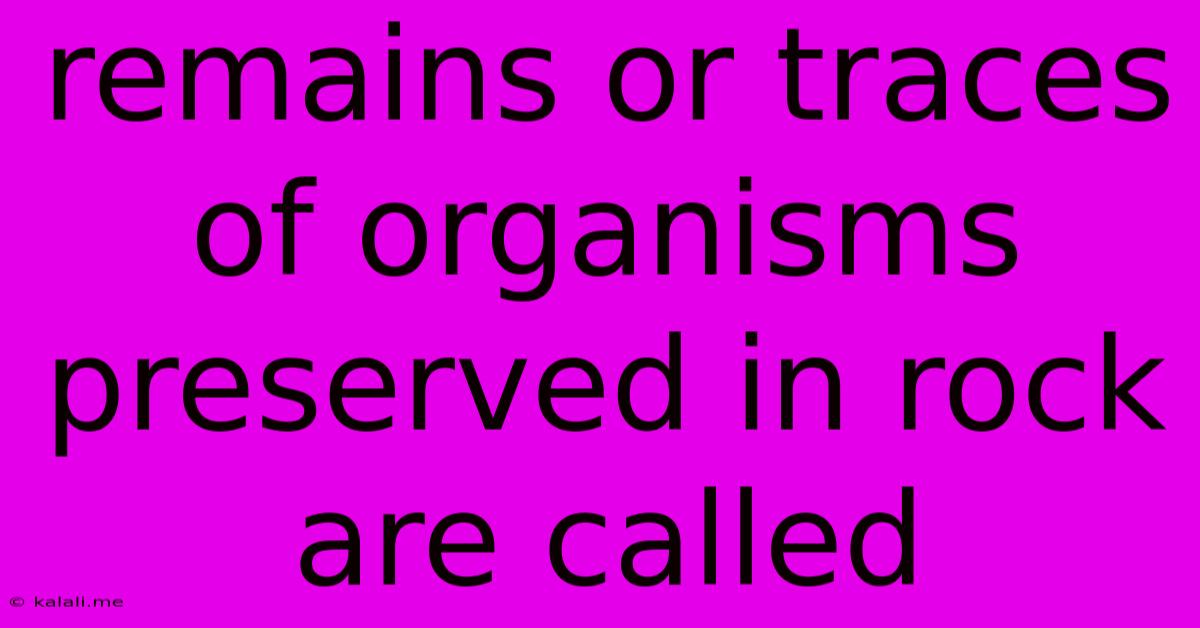Remains Or Traces Of Organisms Preserved In Rock Are Called
Kalali
May 09, 2025 · 3 min read

Table of Contents
Remains or Traces of Organisms Preserved in Rock are Called Fossils
Fossils are the preserved remains or traces of organisms that lived in the past. They provide invaluable evidence about the history of life on Earth, offering insights into evolution, paleoclimatology, and past environments. Understanding how fossils form and what they can tell us is crucial to comprehending our planet's rich and complex biological past. This article will explore the fascinating world of fossils, delving into their formation, types, and significance.
How Fossils Form: A Journey Through Time
Fossil formation is a complex process that requires specific conditions. The most important factor is rapid burial of the organism after death. This prevents decomposition by scavengers and bacteria. The organism's remains then become encased in sediment, such as mud, sand, or volcanic ash. Over time, this sediment hardens into rock.
Several different processes contribute to fossilization:
- Permineralization: Minerals dissolved in groundwater fill the pores and spaces within the organism's remains, solidifying them and preserving the original structure. This is common in wood and bones.
- Replacement: The original material of the organism is dissolved and replaced, molecule by molecule, by another mineral. This can create stunningly detailed fossils, even preserving microscopic structures.
- Carbonization: Organic matter is compressed, leaving behind a thin film of carbon. This is common in plants, resulting in delicate, leaf-like impressions.
- Mold and Cast Fossils: When an organism decays, it can leave a hollow space (mold) in the surrounding rock. If this mold is later filled with minerals, a cast is formed, creating a three-dimensional replica of the organism.
- Trace Fossils: These aren't the organism's remains themselves, but rather evidence of their activity. Examples include footprints, burrows, and coprolites (fossilized feces). These offer indirect but important clues about behavior and environment.
Types of Fossils: A Diverse Collection
The fossil record encompasses a vast array of organisms and preservation types. Some common types include:
- Body Fossils: These are the actual remains of organisms, such as bones, shells, teeth, and leaves.
- Trace Fossils (Ichnofossils): As mentioned earlier, these are evidence of an organism's behavior, not the organism itself.
- Chemical Fossils (Chemofossils): These are organic molecules preserved in rocks, offering clues to the presence of specific organisms.
The Significance of Fossils: Unlocking the Past
Fossils are indispensable tools for understanding the history of life on Earth. They provide:
- Evidence of Evolution: The fossil record shows how species have changed over time, documenting the branching patterns of evolution and the emergence of new traits.
- Information on Past Environments: Fossils can reveal the climate, vegetation, and other environmental conditions that existed at the time they formed. For example, the presence of coral fossils indicates a warm, shallow-marine environment.
- Dating Rocks and Geological Events: Certain fossils are characteristic of specific time periods, allowing geologists to date rock layers and reconstruct the geological history of a region. This is particularly important in stratigraphy.
- Insights into Extinction Events: The fossil record clearly documents mass extinctions, helping scientists understand the causes and consequences of these significant events in Earth's history.
In conclusion, the term fossil encompasses a wide variety of preserved remains and traces of past life. From the delicate imprints of ancient leaves to the massive bones of dinosaurs, fossils offer a window into the deep past, allowing us to piece together the history of life on Earth and understand the processes that have shaped our planet. The study of fossils, paleontology, remains a vibrant and exciting field, constantly revealing new information and insights.
Latest Posts
Latest Posts
-
What Is 21 Cm To Inches
May 09, 2025
-
How Long Is 120 Cm In Feet
May 09, 2025
-
What Layer Of Earth Is Most Dense
May 09, 2025
-
Which Polymer Is Composed Of Amino Acids
May 09, 2025
-
What Is The Percentage Of 38 Out Of 50
May 09, 2025
Related Post
Thank you for visiting our website which covers about Remains Or Traces Of Organisms Preserved In Rock Are Called . We hope the information provided has been useful to you. Feel free to contact us if you have any questions or need further assistance. See you next time and don't miss to bookmark.